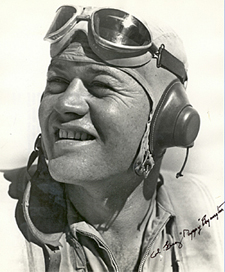


Aviation Hall of Fame inducts Boyington, Rutan
Two individuals who helped shape air travel nationally were inducted into the Idaho Aviation Hall of Fame Saturday night (Sept. 29) during a ceremony in Sagle. ITD’s new Aeronautics Division Administrator Mike Pape participated in the ceremony at the Bird Museum south of Sandpoint that honored aviation legends Burt Rutan and Gregory “Pappy” Boyington.
Both inductees were heralded for their contributions to aviation nationally and internationally
“Pappy” Boyington
Born in Coeur d’Alene on Dec. 4, 1912, Boyington grew up in the nearby logging town of St. Maries and later Tacoma, Wash. He graduated from the University of Washington in 1934 with a bachelor’s degree in aeronautical engineering.
Two years later, he accepted an appointment as an aviation cadet in the Marine Corps Reserve and was assigned to the Naval Air Station in Pensacola, Fla., for flight training.
On July 1, 1937, he accepted a 2nd Lt. commission in the regular Marine Corps. He resigned his commission in the Marine Corps on Aug. 26, 1941, to accept a position with the /American Volunteer Group (AVG), the famed Flying Tigers of China.
In the AVG, Boyington was credited with 3.5 Japanese aircraft destroyed. In the spring of 1942, he returned to the U.S. where he was reinstated in the Marine Corps as a major. He eventually became a commanding officer of Marine Fighter Squadron 21l4, better known by its nickname, the Black Sheep Squadron.
He is best known for his exploits flying the Vought F4U Corsair in VMF-214. During his squadron’s first tour of combat duty, the major shot down 14 enemy fighter planes in 32 days. By the end of 1943, he had shot down 25. He tied the American record of 26 planes on Jan. 3, 19-44, over Rabaul, but was shot down later the same day.
Boyington became a prisoner of war and spent the remaining 20 months of the war in Japanese prison camps. In mid –August 1945, after atomic bombs atomic bombs were dropped on Nagasaki and Hiroshima, he was liberated from Japanese custody. Shortly after his return to the U.S. as a lieutenant colonel, he was ordered to Washington, D.C. to receive the nation’s highest honor, the Medal of Honor.
His medal of honor citation reads, in part: “Major Boyington led a formation of 2l4 fighters over Kahili on October 17, and, persistently circling the airdrome where 60 hostile aircraft were grounded, boldly challenged the Japanese to send up planes. Under his brilliant command, our fighters shot down twenty enemy craft in the ensuing action without the loss of a single ship …”
He received the Navy Cross on Oct. 4, 1945, from the commandant of the Marine Corps. Boyington retired on Aug. 1, 1947, with the rank of colonel. He passed always Jan. 11, 1988.
The Coeur d’Alene airport was renamed the “Coeur d’Alene Airport-Pappy Boyington Field, in his honor of its favorite son in August 2007.
Burt Rutan
Aeronautical engineer Burt Rutan has designed, developed and flight proven many innovative aerospace vehicles from light, home-built airplanes and record-setting long-range aircraft to suborbital space planes.
He was born June 17, 1943, in Oregon and grew up in Dinuba, Calif. He showed an early interest in aviation, designing and building his own model airplanes and piloted his first solo flight at the age of 16.
He majored in aeronautical engineering at California Polytechnic University, graduating third in his Class of 1965. Nine years later, he founded the Rutan Aircraft Factory where he gained acclaim for designing airplanes that could be built at home, such as the lightweight VariEze.
Rutan’s designs were characterized by their unusual appearance with elevator forward (canard configuration) and the use of composite materials such as fiberglass and plastics.
In 1982, Rutan launched a second company, Scaled Composites, which created research aircraft. His fame spread worldwide in 1986 when his aircraft, Voyager, piloted by his brother Dick Rutan, and Jeana Yeager made the first unrefueled flight around the world.
The suborbital space plane, SpaceShipOne, was developed at Scaled Composites. The craft set a new civilian altitude record of 40 miles in May 2004. In October 2004, Rutan won the $10 million Ansari X Prize by sending SpaceShipOne into suborbital flight 42 miles above earth, twice in a two-week period.
He received dozens of awards and recognitions. Six of his aircraft are on permanent display at the Smithsonian National Air and Space Museum in Washington, D.C.
Rutan and his wife, Tonya, returned to Coeur d’Alene in April 2011.
Published 10-5-2012